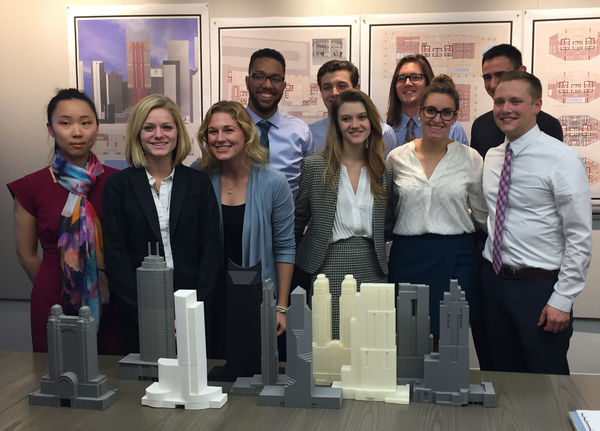
In the lobby of Solomon Cordwell Buenz, a Chicago-based architecture firm, sits a model of downtown Chicago and its towering structures--a testament to the innovative thinkers and designers who built the Midwestern metropolis and pioneered the elevators and metal frames that made high-rise buildings possible. Notre Dame architecture students walked past the city model, while wielding 3D models of the high-rise buildings they designed, to enter the boardroom where their final reviews would take place. These students spent the fall semester in the high-rise studio with Professor John Stamper, Associate Dean and Director of Undergraduate Studies and a leading expert on both the history and development of North Michigan Avenue in Chicago as well as ancient Roman Architecture. Over the course of three months, students learned to look beyond the wonderment of high-rise structures to understand their technological and functional requirements.
The goal of the high-rise studio is to allow students to utilize their traditional educational foundation, produce innovative designs and apply their skill set to high-rise buildings. Professor Stamper believes that “students should have some real world experiences,” and the high-rise studio gives them a chance to design for existing architectural projects in the city of Chicago and express their creative visions in a real world context.
At the beginning of the school year students spent two days in Chicago where they learned about the project site and the history of high rises through lectures by high-rise experts and walking tours led by Prof. Stamper. Each year Prof. Stamper chooses a site location that is in development and has garnered media attention; previous sites include the Spire site and the Loews Hotel site. He typically steers students away from designing supertall buildings which are becoming increasingly popular in Chicago, preferring instead a more contextual and sustainable approach. This year students designed a building for Chicago’s Lakeshore East neighborhood at the future site of Wanda Vista. The site is divided by North Field Boulevard which presented students with a considerable design challenge. The final design required a tower structure that included a commercial street level, a hotel, apartments, and parking. Final review presentations included 3D models of their building designs placed in a base model of the site that students also built.
Throughout the studio, students have freedom to choose their design aesthetic and elements. Prof. Stamper says that each year students present an array of design types--some years display more traditional designs than others. Students utilized their creative liberties and showed their personalities through these designs. Some offered bits of whimsy and fun, which was easily spotted in a building that one juror called batman-esque. And another offered an art deco building with a character reminiscent of the Great Gatsby era. Whatever the aesthetic direction of the students’ design, one of the most important aspects of this project is that students carry out the project from conception to completion, and thus do the work of an entire team by themselves.
The high-rise studio is popular among fifth-year students possibly because there is a striking appeal of the high-rise building that causes people to marvel and wonder about the innerworkings. Prof. Stamper lauds this course because it allows students to build upon their foundation in hand rendering and water coloring by adding experience with design software--students use a combination of Sketch-Up, AutoCad or Revit, and Photoshop. The projects completed in the high-rise studio are often the most large-scale and complex undertakings of the students’ college experience.